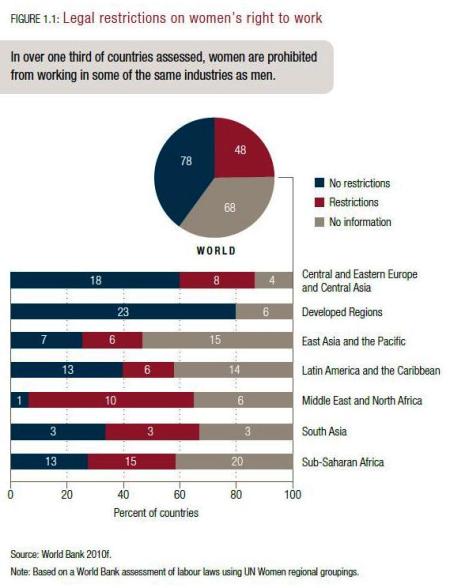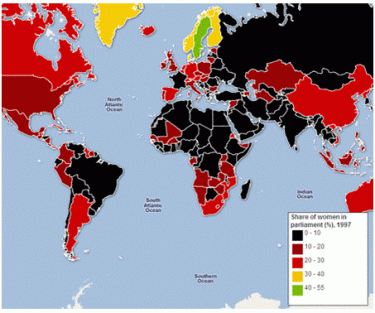This post first appeared on Gender Debate.
In every region of the world, there has been a significant progress on legal reform to expand the scope of women’s rights. Law implementation and enforcement improves women’s access to justice and therefore can advance gender equality. However, a lot of work remains to be done for all women and girls to experience justice, physical integrity and equality in their homes and working places.
UN Women, the newly established United Nations Entity for gender equality and the empowerment of women recently released its biannual flagship report, ‘Progress for the World’s Women in Pursuit of Justice 2011-2012.’
The report highlights the ways in which governments and civil societies should work together to reform laws and create new models for justice service delivery that meets women’s needs. The report also sheds light on the challenge of ensuring that women can access justice in the most challenging situations, including after conflict and in the context of legal pluralism. Women themselves play a central role as agents for change, as legislators, judges, lawyers, campaigners and community activists.
The report focuses on women’s pursuit of justice and it recognizes the positive progress made all over the world, for instance about 139 countries and territories, now guarantee gender equality in their constitutions.
A remarkable advance has been made over the past century in the quest for gender equality and women’s empowerment, particularly in terms of legal rights. Today, 139 countries and territories, now guarantee gender equality in their constitutions. 125 countries have outlawed domestic violence, 115 guarantee equal property rights and women’s voice in decision-making is stronger than ever before. In many countries, legal reforms to expand women’s rights and access to justice have been followed by an increase in women’s representation in parliaments.

Therefore, it is important to continue changing national laws, demanding enforcements of existing laws, striking down discriminatory customary laws and revolutionizing the scope of international law. Making the justice system work for women, for example by catalyzing legal reforms, supporting legal aid and training for judges, requires investment.
Most international organizations recognize the importance of strengthening the rule of, but targeted funding for promoting gender equality in the area of legal and judicial development and human rights has remained low.
In 2009, the OECD allocated $4.2 billion to justice, with US and European Union accounting for 70 per cent of the total. Out of this amount, only 5% were allocated to programs focusing on gender equality as primary aim. 15 per cent were allocated to programs for which gender equality was a secondary aim.
The World Bank has also allocated only a very small fraction of its funding to gender equality focused rule of law projects over the past decade. The Bank’s funding for grants, credits and loans for the years 2000-2010 adds up to 261 billion USD (2946 projects). 6% are allocated to rule of law projects (16 billion USD). The total amount allocated to rule of law and gender equality projects adds up to 61 million USD (0.02%).The total amount allocated to the gender equality components of these projects is only 9.6 million USD (0.004%).
By Angela Luci.
Sources: Angela Luci; The Citizen; UN Women Report
In every region of the world, there has been a significant progress on legal reform to expand the scope of women’s rights. Law implementation and enforcement improves women’s access to justice and therefore can advance gender equality. However, a lot of work remains to be done for all women and girls to experience justice, physical integrity and equality in their homes and working places.
UN Women, the newly established United Nations Entity for gender equality and the empowerment of women recently released its biannual flagship report, ‘Progress for the World’s Women in Pursuit of Justice 2011-2012.’
The report highlights the ways in which governments and civil societies should work together to reform laws and create new models for justice service delivery that meets women’s needs. The report also sheds light on the challenge of ensuring that women can access justice in the most challenging situations, including after conflict and in the context of legal pluralism. Women themselves play a central role as agents for change, as legislators, judges, lawyers, campaigners and community activists.
The report focuses on women’s pursuit of justice and it recognizes the positive progress made all over the world, for instance about 139 countries and territories, now guarantee gender equality in their constitutions.
A remarkable advance has been made over the past century in the quest for gender equality and women’s empowerment, particularly in terms of legal rights. Today, 139 countries and territories, now guarantee gender equality in their constitutions. 125 countries have outlawed domestic violence, 115 guarantee equal property rights and women’s voice in decision-making is stronger than ever before. In many countries, legal reforms to expand women’s rights and access to justice have been followed by an increase in women’s representation in parliaments.
Share of women in parliament 1997
Share of women in parliament 2011
However, despite widespread legal guarantees of equality, the reality for many millions of women is that justice remains out of reach. This often also goes for women’s economic participation:Image Source: http://filipspagnoli.wordpress.com/2009/11/10/human-rights-maps-70-gender-equality-in-government/

Therefore, it is important to continue changing national laws, demanding enforcements of existing laws, striking down discriminatory customary laws and revolutionizing the scope of international law. Making the justice system work for women, for example by catalyzing legal reforms, supporting legal aid and training for judges, requires investment.
Most international organizations recognize the importance of strengthening the rule of, but targeted funding for promoting gender equality in the area of legal and judicial development and human rights has remained low.
In 2009, the OECD allocated $4.2 billion to justice, with US and European Union accounting for 70 per cent of the total. Out of this amount, only 5% were allocated to programs focusing on gender equality as primary aim. 15 per cent were allocated to programs for which gender equality was a secondary aim.
The World Bank has also allocated only a very small fraction of its funding to gender equality focused rule of law projects over the past decade. The Bank’s funding for grants, credits and loans for the years 2000-2010 adds up to 261 billion USD (2946 projects). 6% are allocated to rule of law projects (16 billion USD). The total amount allocated to rule of law and gender equality projects adds up to 61 million USD (0.02%).The total amount allocated to the gender equality components of these projects is only 9.6 million USD (0.004%).
By Angela Luci.
Sources: Angela Luci; The Citizen; UN Women Report


No comments:
Post a Comment